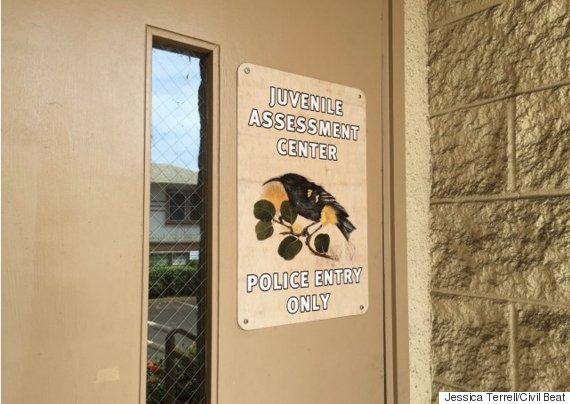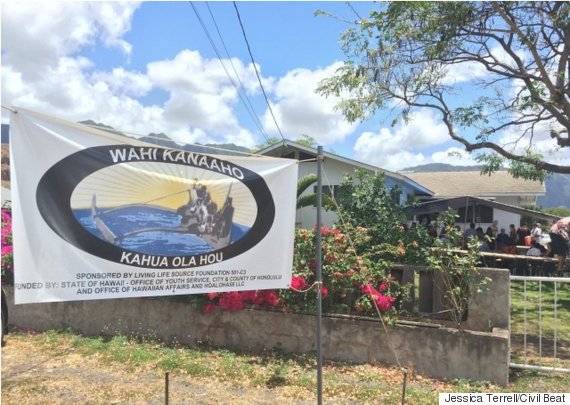 This approach has a cultural component often used by mainland Native American mentoring programs. Listening, learning root causes, physical activities, and other interventions make this applicable anywhere.
This approach has a cultural component often used by mainland Native American mentoring programs. Listening, learning root causes, physical activities, and other interventions make this applicable anywhere. A ‘More Hawaiian' Way To Deal With Delinquent Kids
Angry. Frightened. Sad.
When teenagers are marched in handcuffs through a discreet back entrance at the Susannah Wesley Community Center in Kalihi — or walk through the front door with their parents clutching a police citation — they display a range of emotions.
Mostly they are alienated and calling out for help, case workers say, desperate enough to take a chance on a new program that offers them both the promise of assistance and a clean slate.
The community center is part of the Ho’opono Mamo Civil Citation Initiative, a pilot program launched in Honolulu this spring.
For the next year and a half, first-time juvenile offenders busted for minor law violations in Honolulu’s 5th Patrol District — which includes the neighborhoods of Kalihi, Liliha, Nuuanu and Punchbowl — will be given the option of going to the center instead of going to court.
“These kids don’t need to be criminalized,” said David Hipp, executive director of the Office of Youth Services. “They need to be helped.”

The program is an attempt to provide more immediate intervention services by focusing on strengthening teens’ connection to their families and community.
It’s a new way of doing things based on love and healing and community collaboration, that is changing the juvenile justice system to be “more Hawaiian,” said UH Professor Karen Umemoto.
There’s also a big cultural component, including a new 21-day residential healing retreat for teens centered around Native Hawaiian traditions and ho’oponopono, or “making things right.”
The initiative is the latest step in a sweeping overhaul of the juvenile justice system in recent years.
Advocates of reform say they are trying to fix a system that is too punitive when it comes to minor crimes, doesn’t offer enough services to address the root causes of delinquency, and arrests Hawaiian and Pacific Islander teens at a far higher rate than their peers.
“As a community we have some serious issues with respect to kids that are not being addressed,” Oahu Senior Family Court Judge R. Mark Browning said. “Kids should be our number one priority, and sometimes they are not.”
Plentiful Arrests for Minor Crimes
Compared to large cities on the mainland, Honolulu doesn’t have much of a hardcore juvenile crime problem.
The city — and the state— posts a relatively low rate of felonies and violent crimes for both juveniles and adults. But the state arrests kids at a much higher rate than national average for so-called “status offenses” — acts that would not be criminal for adults, such as truancy, curfew violations, running away from home or being “beyond parental control.”
Truancy or other status offenses were responsible for more than half of the 8,818 juveniles arrests on Oahu, Maui and Hawaii Island in 2014. Statistics for Kauai were not available because of a recent switch in computer systems. Nationally, status offenses made up just 18 percent to 20 percent of juvenile arrests.
“We have a very large population of youth who are involved in the juvenile justice system for very low-level crimes or offenses,” Umemoto, one of the researchers who will be studying Ho’opono Mamo’s results, said. “I think we have found that the practice has been to treat minor level or low level status offenders in ways that in other states more serious violent offenders are treated.”
There are also big racial disparities among youths the state is arresting and locking up.
A 2012 study by University of Hawaii researchers, including Umemoto, showed that Hawaiian and Pacific Islander youths are arrested at a much higher rate than their peers. The study also found that once arrested, Native Hawaiian and Pacific Islander youth were more likely to receive harsher decisions than their white and East Asian (Chinese, Japanese and Korean) peers.
Though family court judges made a decision several years ago not to sentence teens to jail for status offenses, more than half of the teens sent to the Hawaii Youth Correctional Facility in 2013 had committed misdemeanors.
And locking up a teen in Hawaii is costly. In 2013, the state spent $199,320 for each bed in the HYCF.
One big driver of reform in recent years has been the Hawaii Juvenile Justice Working Group, which includes representatives from HPD, the Office of Youth Services, Family Court, and various community groups.
House Bill 2490, which was signed into law last summer as Act 201 and based in part on recommendations from the group, calls for a 50 percent reduction in the number of juveniles locked up over the next five years.
There is still, however, only one residential facility in the state where judges can send teens dealing with substance abuse issues, and no real residential option for those dealing with mental health issues, Browning said.
Of the roughly 5,000 kids who have a court date in Oahu each year, Browning estimates 80 percent are battling some form of addiction.
The biggest issue, Browning says, is that the justice system doesn’t do enough to address trauma — something the working group is trying to change through the new Ho’opono Mamo initiative.
“We have moved to a trauma-informed care system,” Browning said. “But you have to figure out what the trauma is, and that’s not something we were really aware of eight or 10 years ago.”
And because so many of the teens entering the juvenile justice system are Hawaiian, new programs need to take a more holistic and cultural approach, the working group said.
Immediate Action
Not every teen picked up by HPD in Kalihi qualifies for the pilot program.
Teens have to be first-time offenders busted for minor crimes. And they have to choose to participate.
Once they do, the police either take them to the assessment center at the Susannah Wesley Community Center or issue them a citation directing them to show up at the center the next day.
The immediacy is a big deal, say members of the Juvenile Justice Working Group, because teens often need help when they are arrested and possibly in crisis — not months later when they have a court date.
Staff members were expecting one or two teens a week to sign up for the program, said Ron Higashi, executive director of the Susannah Wesley Community Center. Instead, there’s been more than one teen a day on average since opening in mid-March, and the center is hiring additional staff.
The first step is just listening to the kids and trying to find out what’s going on, before matching teens with local service organizations.
“We want to know how is your family life? How is your social life?” said assessment center program director Shelly Guira. “We also talk about trauma history, legal history.”
Guira and her staff also talk to parents before helping to create a plan for the teens that could involve substance abuse treatment, family counseling, education programs, or emergency shelter for runaways. Sometimes it will mean matching teens with a local kupuna or elder who can mentor them in getting on a different path.
An overarching goal is also to get the teens to set personal goals for themselves for anything from dealing with bullying and peer pressure to improving grades.
Getting teens to feel more connected to their family and the community is also a big part of the program. To do that, some will now be referred to a 21-day residential program in Waianae that opened last weekend.
A Cultural Approach

Wahi Kanaaho is a three-week program tied to the phases of the moon and centered on finding balance and spiritual healing.
The curriculum, created by Juvenile Justice Working Group member and substance abuse counselor Wayde Lee, combines hands-on activities like fishing and farming with reflective individual and group work.
“I teach them how to take care of the ocean, take care of the land, and then the same way they do that take care of themselves,” Lee said.
The new residential center in Waianae is located in a plain white house donated temporarily by a local church. Teens will come to Waianae in small, single-gender groups for self-reflection exercises and lessons in Native Hawaiian cultural values and healing practices.
Wahi Kanaaho staff member Jazlyn Wandasan says the idea of culture-based healing can perhaps be best compared to art therapy. Activities like cleaning out taro patches can be used as a way of getting teens to reflect on their own healing and cleansing.
The program may be new, but the concept is old, said Kehaulani Lum of the Living Life Source Foundation, which is helping fund the program.
“It’s a reawakening of traditional knowledge,” Lum said.
For the next year UH researchers will pore through data from the assessment center to try and quantify whether the program is successful in reducing recidivism and improving the teens’ social and emotional well being. They will look at arrest records, before and after surveys from the teens, and school records — if parents give them permission for that.
Lee has a simpler metric for measuring success.
The imposing and heavyset man looks for two things from teens by the time they leave his program: How in touch they are with their own emotions during a meeting with their parents at the end of the program, and whether they stop of their own accord on a nature walk to pick up an item of rubbish that he discretely places along the path ahead of time as a test.
If they cry during the meeting with their parents, he knows they are in touch with their feelings. If they notice the trash and pick it up, they have malama aina and a sense of their place in the world.
And if they have both of those, Lee says, “I know they are going to be OK.”
Preliminary results on the pilot program will be compiled at the end of the year.
Ret. 5-13-15


No comments:
Post a Comment